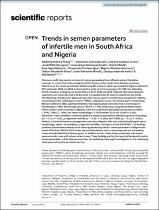| dc.description.abstract | There are conflicting reports on trends of semen parameters from different parts of the globe.
However, in recent times there is dearth of information on the trend in Sub-Saharan countries.
Therefore, in this study we aimed at determining the trends in semen parameters in Nigeria and South
Africa between 2010 and 2019. A retrospective study of semen analyses of 17,292 men attending
fertility hospitals in Nigeria and South Africa in 2010, 2015 and 2019. Patients who had undergone
vasectomy and those who had a pH less than 5 or greater than 10 were excluded from this study.
The following variables were assessed: ejaculate volume, sperm concentration, progressive motility,
total progressively motile sperm count (TPMSC), total sperm count, and normal sperm morphology.
Between 2010 and 2019, significant trends of decreasing values were observed in normal sperm
morphology (− 50%), and the ejaculatory volume (− 7.4%), indicating a progressive deterioration
of the values in both countries. In Nigeria, there were significant decreases in progressive motility
(− 87%), TPMSC (− 78%), and sperm morphology (− 55%) between 2010 and 2019 (P < 0.001).
Spearman`s rank correlation revealed significant negative associations between age and morphology
(ρ = − 0.24, P < 0.001), progressive motility (ρ = − 0.31. P < 0.001), and TPMSC (ρ = − 0.32, P < 0.001).
Patients in South Africa were younger than those from Nigeria, with also a significantly higher sperm
morphology, sperm concentration, progressive motility, total sperm count and TPMSC. Our findings
provide a quantitative evidence of an alarming decreasing trend in semen parameters in Nigeria and
South Africa from 2010 to 2019. It also proves that astheno- and teratozoospermia are the leading
causes of male infertility in these regions. In addition to this, it also shows empirically that semen
parameters decrease with advancement in age. These findings are the first report of temporal trends in
semen parameters in Sub-Saharan countries, necessitating a thorough investigation on the underlying
factors promoting this worrisome decline. | en_US |

